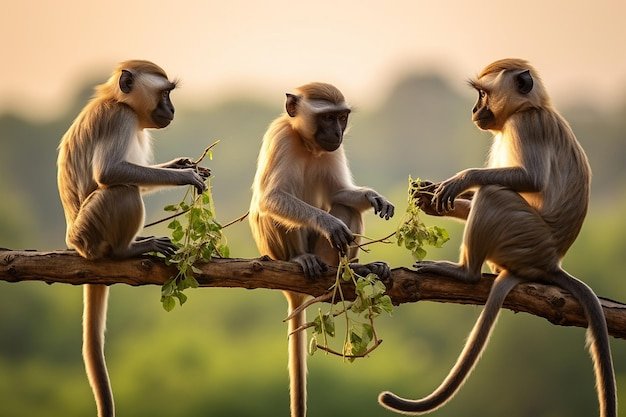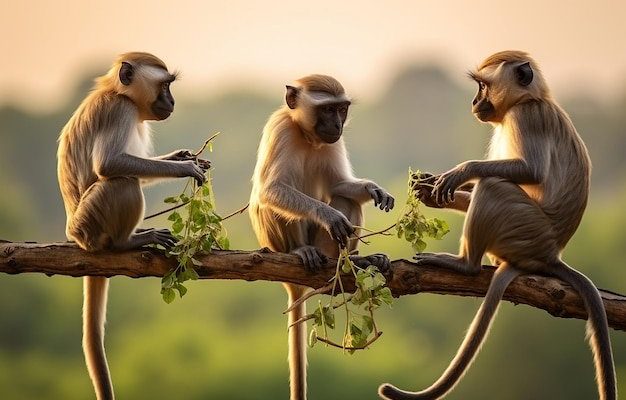
Let’s dive deeper into the world of monkey diets and hunting strategies. You might be surprised at how these clever animals adapt to their surroundings. From tropical rainforests to savannas, their choices in food and ways of hunting reveal a lot about their intelligence and resourcefulness. So grab a cup of coffee and let’s explore how monkeys make food choices, what they hunt, and how they manage to thrive in their habitats.
Understanding Monkey Diets
Monkeys are not all the same when it comes to what they eat. Different species have developed specific diets based on what’s available in their environments. Some monkeys are primarily herbivores, while others lean towards a more omnivorous lifestyle. Let’s break down these dietary categories.
Herbivorous Monkeys: The Plant Eaters
Some monkeys, like the howler monkey, mainly munch on leaves, flowers, and fruits. These plant-based eaters are experts in utilizing what their environment has to offer. For example, howler monkeys have strong, muscular jaws that allow them to chew tough leaves. You might think leaves aren’t very nutritious, but they are high in fiber and can fill these monkeys up.
Here’s the interesting part—herbivorous monkeys often have to travel far and wide to find enough food, since many leaves are low in calories. That means they spend a lot of time foraging in trees, and their social structures help them communicate effectively about where to find the best munchies.
Omnivorous Monkeys: The Food Variety Seekers
On the flip side, we have omnivorous monkeys like the capuchin monkey. These little guys eat just about anything! From fruits and nuts to insects and small animals, their diet is incredibly varied. Capuchins are known for their intelligence and problem-solving skills, which help them find food in challenging situations.
For example, capuchins use tools to crack open nuts and may even work together to catch small prey. You might be wondering how they even manage to find their food. Well, they have incredible memories and social hierarchies that guide their foraging activities. This means they often know where to go for the best food, which is essential for their survival.
Hunting Strategies of Monkeys
While many monkeys primarily gather food, some are quite adept at hunting. Their strategies can be surprising, especially considering their primarily plant-based diets. Understanding how monkeys hunt can give us insights into their behavior and social structures.
Group Hunting Tactics
Some monkey species engage in group hunting, where they work together to catch prey. Take the savanna baboon, for example. Baboons are known to hunt smaller mammals like birds and rodents. They use teamwork and communication to effectively coordinate their hunting efforts.
You might think of a football team strategizing a play—baboons often form a circle to trap their prey, making it easier to catch them. This teamwork not only ensures a meal but also strengthens their social bonds.
Solitary Hunting Techniques
On the other hand, we have monkeys like the spider monkey, which generally hunt alone. These monkeys rely more on their agility and speed. Spider monkeys are excellent climbers and can quickly navigate through trees to catch birds or insects. Their long limbs help them swing effortlessly from branch to branch, making them formidable hunters in their environment.
A notable hunting technique of solitary hunters involves stalking their prey silently and waiting for the perfect moment to strike. It’s a game of patience, much like waiting for just the right moment to take your shot in a game of darts!
Social Dynamics in Foraging
Monkeys are incredibly social creatures, and their foraging habits are often influenced by their group dynamics. The way they hunt and gather food can provide insights into their social structures and relationships.
Hierarchy and Access to Food
In many monkey communities, there is a clear hierarchy. Higher-ranking individuals often have first access to food sources. For example, Japanese macaques have been observed forming social hierarchies, where dominant members lead the group to food. This not only affects who gets to eat first but also influences the foraging strategies of lower-ranking members.
You might notice this dynamic is similar to how people sometimes feel about workplace promotions. If you’re at the top, you likely have better access to resources—this is true in both human and monkey societies.
Learning from Each Other
Another fascinating aspect of monkey foraging is their ability to learn from one another. Young monkeys often observe older, more experienced individuals to learn effective foraging techniques. This social learning is crucial for their survival and helps pass on knowledge within the group.
For example, a young monkey might watch its mother open a tough fruit and imitate her actions later on. This not only helps with individual development but also strengthens the social bonds within the group, creating a supportive community.
The Role of Environment in Diet
Monkeys adapt their diets based on the environment they inhabit. This adaptability is key to their survival and can also vary significantly from one region to another.
Rainforest Monkeys vs. Savanna Monkeys
In the lush rainforests of Central and South America, monkeys such as squirrel monkeys thrive on a diet of fruits, leaves, and insects. Their environment is filled with a variety of food sources, often allowing them to be selective about their meals.
Conversely, in the savanna, species like baboons and macaques have adapted to more open environments, where food may be less plentiful. These monkeys often rely on a mix of hunting and foraging for roots and seeds. Their ability to diversify their diet based on available resources is a testament to their resilience.
Seasonal Changes and Food Availability
Seasonal changes also play a significant role in monkey diets. During certain times of the year, specific fruits may ripen, making them more accessible. For instance, when fruit is abundant, monkeys might focus on gathering and consuming as much as possible to store energy.
Conversely, during dry seasons, when food is scarce, they might need to rely more on foraging for leaves or even scavenging. This adaptability ensures that monkeys can navigate the ups and downs of food availability, demonstrating their cleverness and survival instincts.
Monkeys exemplify the rich tapestry of life in the animal kingdom through their diverse diets and hunting strategies. From playful herbivores to cunning omnivores, these creatures have mastered the art of survival. They adapt to their surroundings, form social bonds, and use impressive strategies to gather food.
As we explore their behavior, it becomes clear that monkeys have an intricate understanding of their environment—much like how we adjust our meal plans based on what’s in the fridge. So, the next time you see a monkey swinging through the trees, remember there’s a lot more going on than just a cute exterior; they’re intelligent creatures navigating the complexities of food, survival, and social dynamics.

